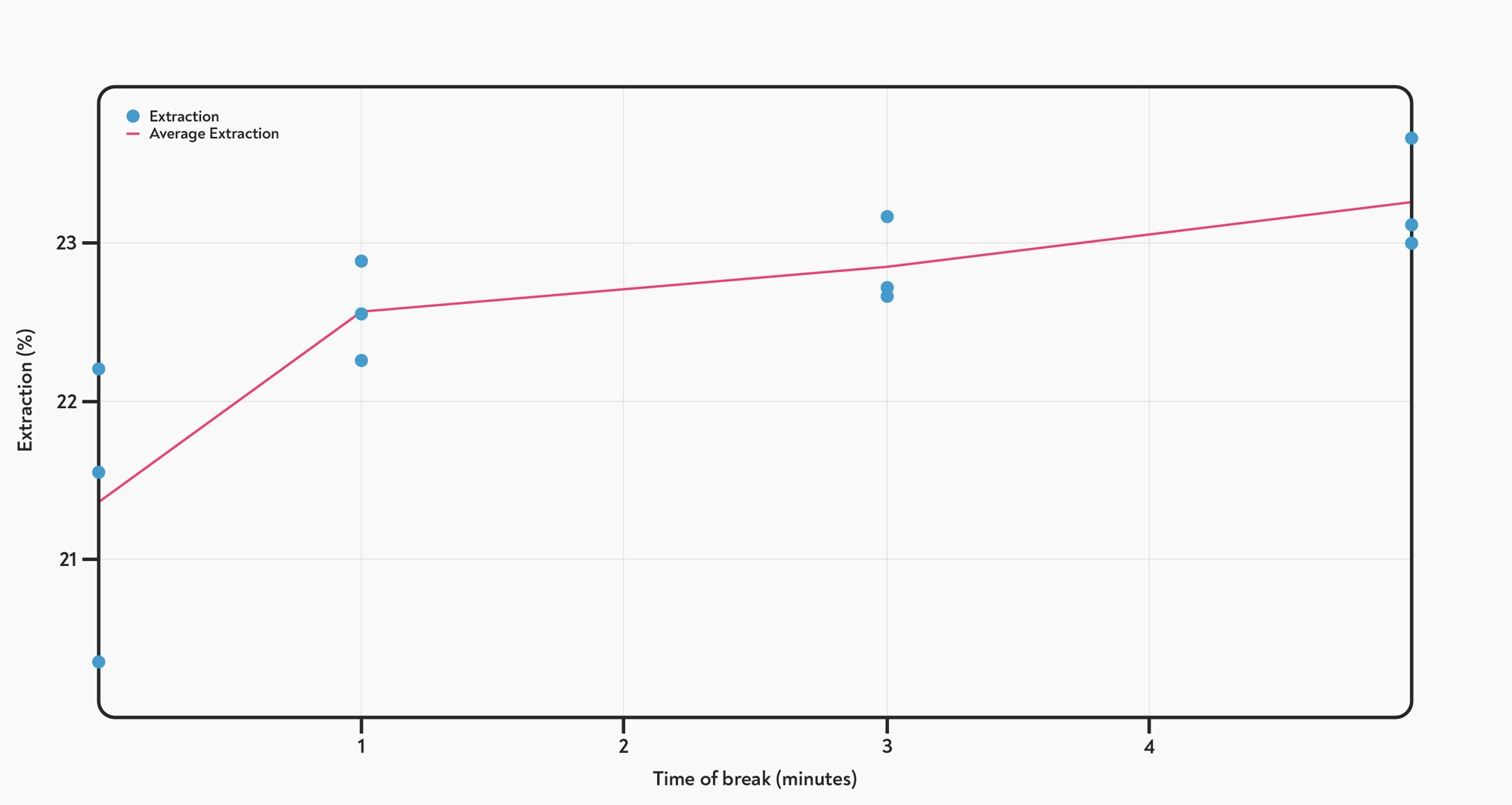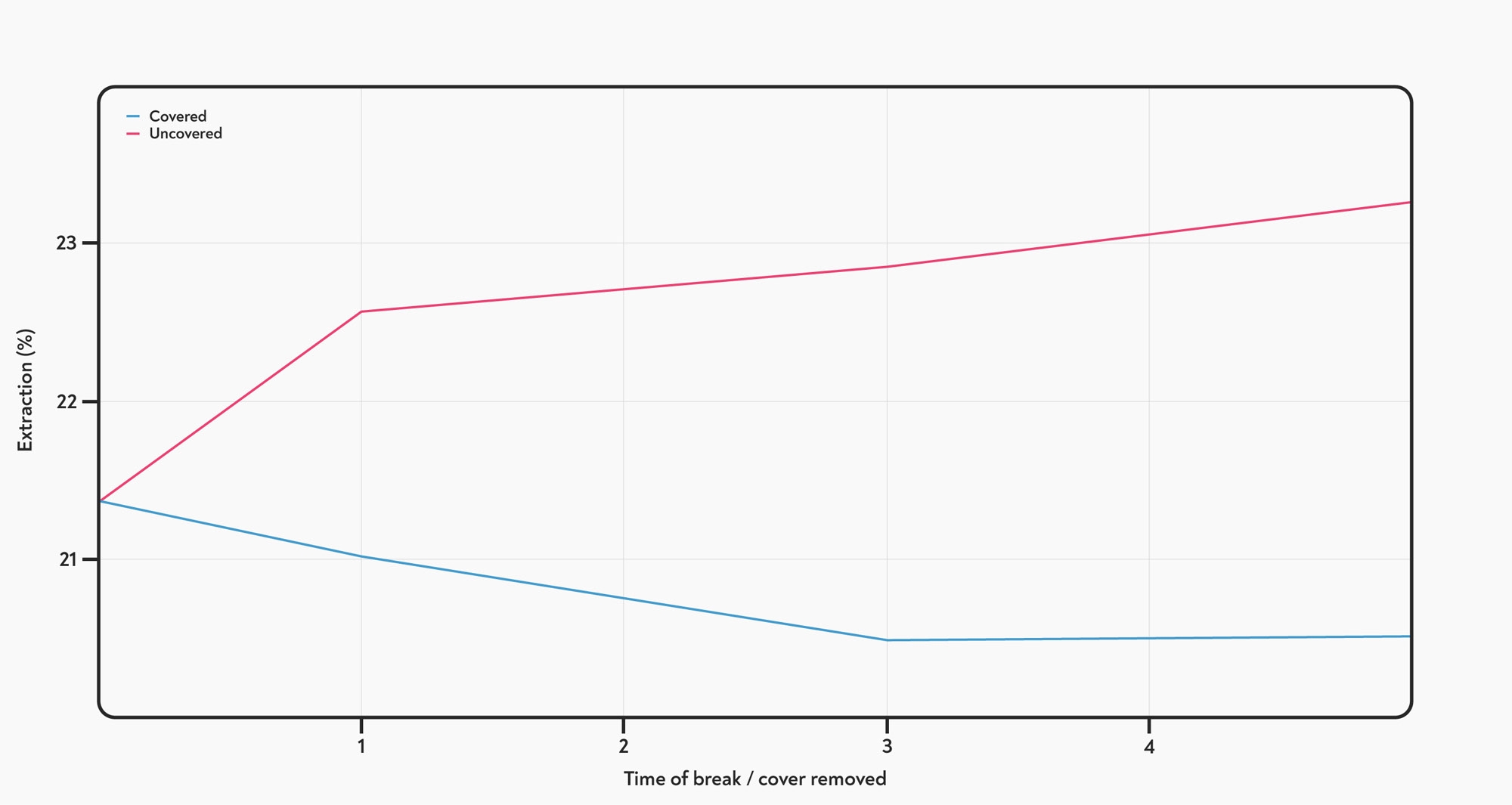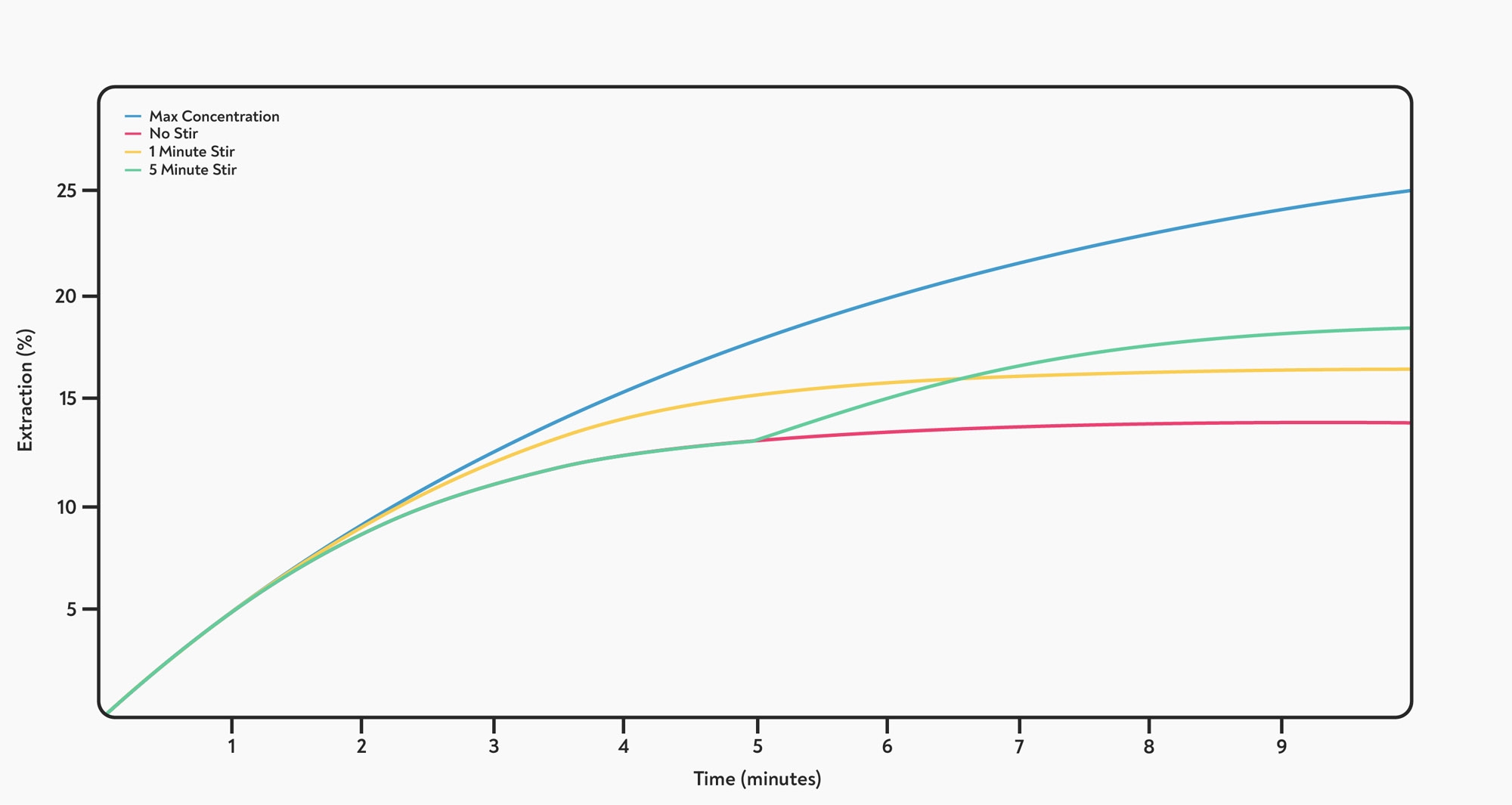by BH Learn
Introduction – SCA cupping guidelines state that breaking the crust should take place after 3-5 minutes. In practice, many coffee professionals aim to break the crust exactly 4 minutes after pouring each cup, but in larger cuppings it’s not always possible to be this accurate.
Cupping is supposed to ensure all coffees get the same treatment, so that any difference between cups are due to differences in the beans or roast, not the brewing method. We looked into how important the timing of the break is, and noticed that breaking the crust later, after 5 minutes rather than 3, seemed to lead to higher extractions.
We suspected that the crust might be insulating the surface of the coffee, keeping the temperature up during the steeping time, and thus allowing for slightly higher extractions. We set up an experiment to test this idea out, and to establish exactly how important the timing of the break is.
What we found isn’t what we expected: insulating the surface of the cups seems to have little effect. However, we did come up with a purely mathematical approach that might explain why breaking the crust later can lead to higher extractions.
The Experiment
We set up two parallel cuppings of the same coffee, all from the same roast batch. In the first set, the crust was broken in each cup, by stirring to the bottom 4 times, at different times: immediately after pouring, or 1, 3, or 5 minutes after pouring. In the second set, to see if insulation alone explains the effect of breaking the crust later, we broke the crust immediately and then covered the bowl with a sheet of expanded polystyrene for 1, 3, or 5 minutes.
Three cups were assigned to each treatment, and pouring alternated between treatments to even out any effects such as temperature change in the brewing water.
All cups were skimmed 6 minutes after pouring, and extraction readings were taken at 10 minutes after pouring. Extraction samples were taken from 1cm below the surface of the coffee, and kept aside in a pipette to cool fully before readings were taken.
Results
Breaking the crust later did indeed increase the average extraction. Trying to break the crust immediately after pouring led to very inconsistent results, but for breaks at 1, 3, and 5 minutes, a clear upward trend is visible.
 Figure 1: The effect of breaking at different times on the final extraction % in a cupping
Figure 1: The effect of breaking at different times on the final extraction % in a cupping
Covering the cups, however, didn’t increase extraction. A polystyrene sheet is a very effective insulator, so if the crust was having any effect on temperature loss we’d expect to see a strong effect from polystyrene insulation, so we can safely rule out our hypothesis.
 Figure 2: Comparing breaking the crust at different times against breaking the crust immediately and then covering the bowl
Figure 2: Comparing breaking the crust at different times against breaking the crust immediately and then covering the bowl
In fact, the extraction of the covered cups decreased over the course of the experiment — something that is probably attributable to an uncontrolled factor in the experiment such as the ambient conditions or the temperature of the grinder. When you take this into consideration, the increase in extraction when breaking the cups later is even more striking. All the covered cups were broken at time 0. The cups broken after 5 minutes had nearly 3 full percentage points higher extraction than the cups that were broken and then covered for 5 minutes.
An alternative explanation
So it’s clear that while breaking the cups later seems to increase extraction, it’s not because the crust is insulating the cup in any way. We went back to the drawing board, and realised that it’s possible to explain what’s happening just by considering the extraction kinetics in a cupping bowl.
First, we start with the assumption that the maximum possible extraction at any time is proportional to the amount remaining to be extracted — in other words, that extraction is fast at first, but when it approaches the maximum (about 30%) it slows down, as the concentration of the brew approaches equilibrium with the coffee. The blue line in the graph below represents this.
In a cupping however, after the initial pour, the coffee begins to settle down. When this happens, the solubles can only reach the brew by diffusing to the surface of the bed. To account for this, we assume the rate of extraction slows down with time.
The red line in this graph shows what happens if we assume that the proportion of the maximum extraction rate we can achieve is inversely proportional to the time after pouring. In other words, shortly after pouring, extraction is near maximum as the coffee particles and water are circulating together. After about 3 minutes, the coffee has settled considerably and the extraction rate is only half of what it could be if the coffee was still being stirred: by 5 minutes, the extraction rate is close to 0.
Next we model what happens when we stir. If we assume that stirring resets the clock on the coffee settling, the extraction rate at the time of stirring goes back to what the maximum rate would be at that concentration, and then gradually goes back to 0 as the coffee settles.
 The yellow line in this graph shows the effect of this on stirring after 1 minute. At this time, the actual extraction rate isn’t far from the maximum as the coffee hasn’t fully settled. It delays the settling effect by a minute, allowing extraction to proceed slightly further.
The yellow line in this graph shows the effect of this on stirring after 1 minute. At this time, the actual extraction rate isn’t far from the maximum as the coffee hasn’t fully settled. It delays the settling effect by a minute, allowing extraction to proceed slightly further.  Next, let’s look at what happens with a 5 minute stir.
Next, let’s look at what happens with a 5 minute stir.
The green line shows the effect of a stir after 5 minutes. For the first 5 minutes, the extraction is the same as in the unstirred cup, so it falls below the cup stirred at 1 minute. But after stirring, the extraction rate briefly goes back up to the maximum rate for that concentration, allowing extraction to jump up and overtake the 1 minute stir.
If you find this hard to get your head around, let’s consider the effect of stirring at two specific times. Firstly, let’s imagine what happens if you stir immediately after pouring. Since the pour itself already agitates the coffee a lot, stirring at this time has a small effect as the coffee hasn’t yet begun to settle. So in this model, a stir at time 0 has virtually no effect on extraction.
Next, imagine what happens if you stir after a very long time, when the coffee has completely extracted. At this point, stirring will have no effect as there’s no extraction to be done. So this means stirring at the start and at the end of the cupping have little to no effect on extraction. However, it’s pretty common sense that stirring in the middle of the cupping does boost extraction — so there must be a time in between that gives extraction the biggest boost, and it turns out that this peak stirring time appears to be closer to 5 minutes after pouring than 3 minutes.
A side note
While the stirring time had a measurable effect on extraction, this effect was dwarfed by the difference in extraction we found between the first cups and last cups we poured from each kettle. This is likely due to the water cooling in the kettle as we moved along the row, even though we only poured 3 cups from each kettle to try and minimise this effect.
This shows that heat loss is clearly an issue, even though the crust isn’t playing a part here. Instead, most of the heat is probably lost to the material of the cupping bowls — as we used ceramic bowls for this experiment. As BH readers hopefully know by now, plastic is by far the better material for brewing equipment for this reason — and this is why we decided to make our own cupping bowls out of plastic.




0 Comments